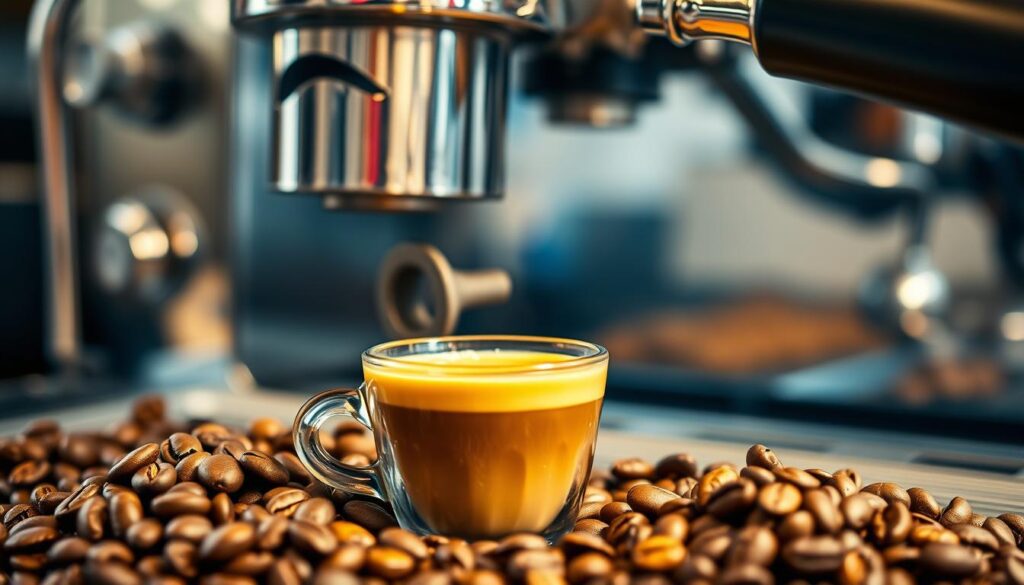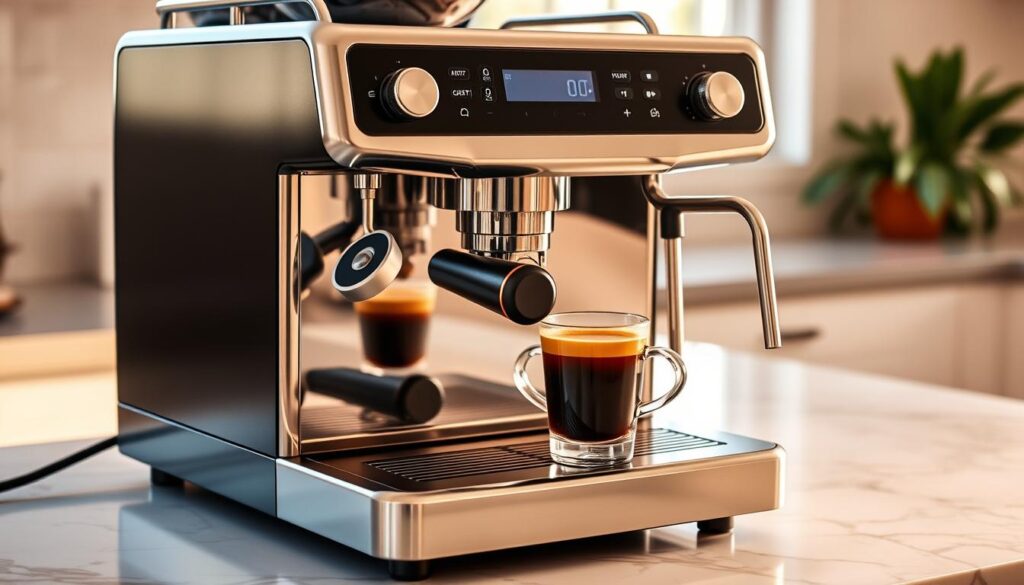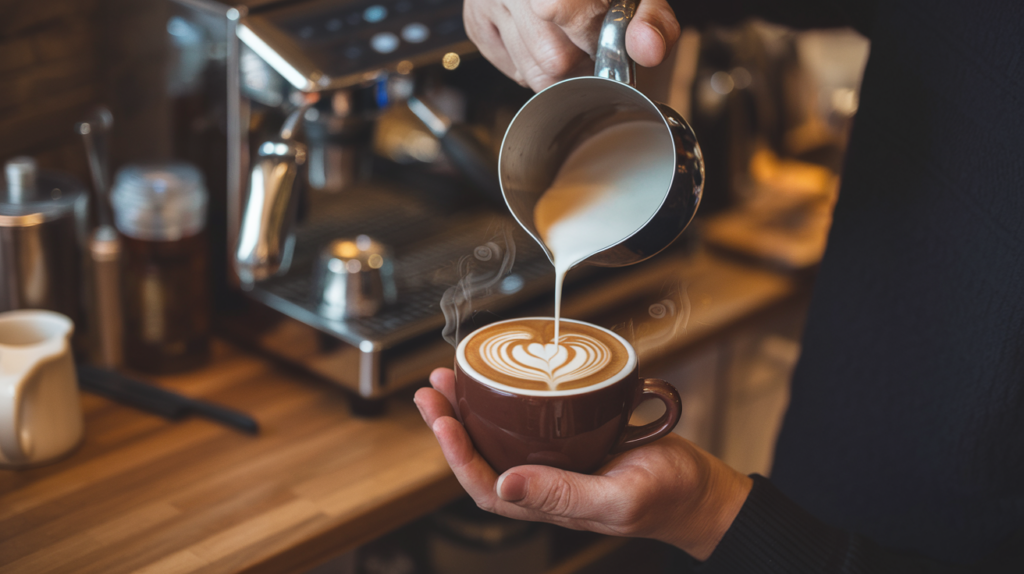This website contains affiliate links. As an Amazon Associate, I earn from qualifying purchases. The content on this website was created with the help of AI.
Getting the perfect espresso is more than just using top-notch beans. It’s about knowing how to adjust your espresso machine’s settings. The right balance of pressure, temperature, and grind size is key. These espresso machine adjustments are crucial for the taste and texture of your coffee.
Getting these settings just right can elevate your espresso from good to great. This lets you enjoy a rich and balanced cup in your own home. By learning how each setting impacts the coffee, you can tailor your machine to your taste. Are you ready to learn about pressure, temperature, and grind size for the perfect espresso?
The Importance of Espresso Machine Settings
Understanding the importance of espresso machine settings is key for anyone wanting perfect brew. Each setting, like pressure, temperature, or grind size, is vital for the final espresso quality. By adjusting these, you can turn a simple coffee into a rich, flavorful cup.
Why Settings Matter
Espresso machine settings are crucial because they impact the brewing process. Getting them right means every shot tastes the same, making it easier to get the taste you want. For example, adjusting pressure helps extract oils and flavors well.
Temperature settings also affect how flavors are extracted and stay stable. If not set right, you might get a sour or bitter coffee. This is why settings are so important.
Impact on Flavor and Quality
The taste and quality of your espresso depend on your machine settings. Adjusting the grind size ensures even extraction. Precise pressure settings lead to a balanced shot with great crema.
Temperature control is also key; small changes can affect the espresso’s taste, changing its acidity and sweetness. Getting these settings right makes your espresso stand out, offering a memorable experience.
By monitoring and adjusting your espresso machine settings, you embrace the art of coffee making. This approach ensures every cup is perfect, pleasing both new and experienced coffee lovers.
Understanding Espresso Machine Pressure
Exploring the world of espresso, espresso machine pressure is key. It’s crucial for getting the optimal extraction needed for a great shot. Baristas talk about “nine bars” of pressure, but what does it mean and how does it impact your coffee?
Optimal Pressure Levels
“Nine bars” is the pressure used during extraction. It’s seen as optimal for bringing out the best in coffee flavors. This pressure ensures water flows through the coffee grounds just right, avoiding too little or too much extraction.
Adjusting Pressure for Different Beans
Each coffee bean might need a special pressure setting for the optimal extraction. Darker roasts might need less pressure because of their softer grind. Lighter roasts might do better with more pressure. By adjusting the pressure, you can tailor the extraction to each bean’s unique taste.
Common Problems with Pressure
Even with the right knowledge of espresso machine pressure, problems can still happen. Issues like uneven pressure, leaks, and trouble keeping the right pressure can occur. These problems can make your shots less than perfect, needing regular checks and fixes to keep your machine working well.
Learning to adjust pressure can greatly improve your espresso skills. It helps make each shot rich, balanced, and full of flavor.
Mastering Espresso Machine Temperature
Getting the temperature right in your espresso machine is key to a great brew. A consistent temperature brings out the best flavors in your coffee. Let’s explore how to manage temperature effectively.
Ideal Temperature Range
Your espresso machine should be between 195°F and 205°F for the best extraction. This range helps get the coffee’s oils and flavors right, avoiding bitterness or sourness. Staying within this range is essential for a perfect shot every time.
Temperature and Brew Time
Brew time and temperature are closely linked. Changing the temperature can alter how long it takes to brew your espresso. A lower temperature might need a longer brew, while a higher one could be quicker. But, both should aim for a balanced shot.
Maintaining Stable Temperature
Keeping the temperature stable is vital for back-to-back shots. Machines from La Marzocco and Breville have advanced controls for this. Regular checks and upkeep are crucial to keep your machine consistent.
| Machine Model | Temperature Stability Features | Ideal Temperature Range |
|---|---|---|
| La Marzocco Linea Mini | PID Controller, Dual Boiler | 195°F – 205°F |
| Breville Barista Express | Thermocoil Heating System | 195°F – 205°F |
The Role of Grind Size in Espresso Making
Grind size is key in making espresso. It’s one of the three main settings that affect how your espresso tastes. Getting the right grind size through precise grind calibration is crucial for a perfect cup.
How Grind Size Affects Extraction
Grind size is vital for extraction. Finer grinds mean more surface area for water, leading to quicker extraction. Coarser grinds, on the other hand, take longer. This greatly changes your espresso’s flavor and texture.
Choosing the Right Grind Size
Finding the right grind size depends on your espresso machine and beans. An espresso grind adjustment ensures the grind fits your machine’s needs, improving flavor. Machines from Breville or DeLonghi have specific grind size preferences for the best taste.
Adjusting Grind Size for Consistency
Consistency is essential for a great espresso. Adjusting and fine-tuning your grind size helps achieve precise grind calibration. This ensures every shot is balanced and flavorful. A good grinder with micro-adjustments greatly improves your espresso’s consistency.
Every espresso setup is different. Mastering these adjustments can elevate your espresso-making skills. It leads to a consistently exceptional cup every time.
Optimizing Espresso Flavor Through Machine Settings
To get the perfect espresso flavor, you need to know your machine’s settings well. By tweaking these settings, you can make the flavor just right for you. Here are some key espresso brewing tips to help you on your flavor journey.
Tasting Notes and Adjustments
Understanding tasting notes is key to improving flavor. Keep a journal of your espresso’s taste. Note the sweetness, acidity, and bitterness balance. If it’s too sour, try a finer grind to slow down extraction and reduce acidity.
If it’s too bitter, a coarser grind might help. Also, adjusting the brewing temperature can change the flavor a lot.
Experimenting with Settings
Don’t hesitate to try different espresso custom settings to find your favorite. Change the brewing time, water temperature, and pressure to explore new flavors. For example, longer brewing time can make the espresso more full-bodied.
Changing the pressure can make the taste more intense and rich.
Benefits of Customization
Customizing your espresso settings has many benefits. By adjusting the grind size, pressure, and temperature, you can discover flavors not found in commercial coffee. This process is not only about improving flavor but also makes brewing fun and rewarding.
Every change brings you closer to the perfect espresso.
Common Mistakes to Avoid with Espresso Machine Settings
Whether you’re new to espresso or have been making it for years, espresso troubleshooting is key. Knowing how to avoid common mistakes can help you get that perfect shot every time. We’ll look at common errors with espresso machine settings, like pressure, temperature, and grind size.
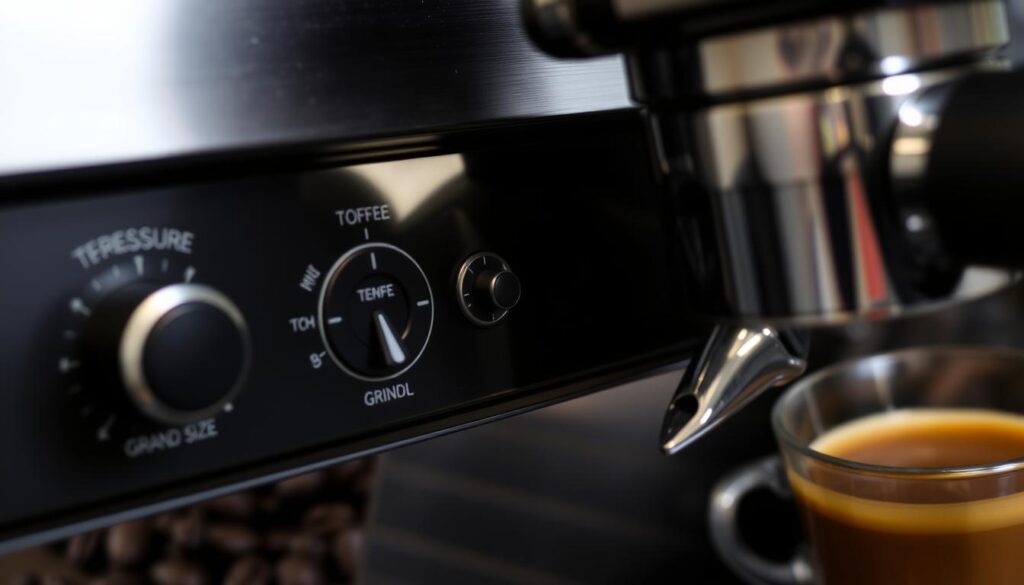
Too Much or Too Little Pressure
Many people make the mistake of using too much or too little pressure. Too much pressure can make your espresso taste bitter and burnt. Too little pressure can make it weak and sour. Adjust your machine’s pressure settings based on the beans you’re using to avoid espresso errors.
Incorrect Temperature Settings
Temperature is important for getting the right flavors from your coffee. If it’s too high, it can burn the coffee. If it’s too low, it won’t extract enough flavor. Finding the right balance is crucial. Keeping the temperature consistent helps with espresso troubleshooting.
Improper Grind Size
Grind size greatly affects your espresso’s quality. A grind that’s too fine can cause problems and clog the machine. A grind that’s too coarse will make your espresso weak. Adjust your grinder to match your desired taste and extraction time. Knowing these pitfalls can make a big difference in your brewing.
Advanced Espresso Brewing Techniques
For those who love the technical side of coffee, advanced espresso techniques can really elevate your brew. Learning to “dial in” your espresso, using a PID controller for temperature, and mastering pressure profiling can lead to the perfect cup.
Dialing In Your Espresso
Dialing in your espresso means tweaking the grind, dose, and extraction time for the perfect flavor. Begin by accurately measuring your coffee and water. Adjust the grind until the espresso flows smoothly and tastes balanced. This step is key to consistent shots.
Using a PID Controller
A PID controller keeps your brewing temperature stable and precise, which is vital for great espresso. Unlike old thermostats, PID controllers adjust the temperature constantly. This ensures each shot is made at the best temperature, boosting flavor and aroma.
Advanced Pressure Profiling
Mastering pressure profiling lets baristas control the pressure during brewing. By changing the pressure, you can discover new flavors and increase your espresso’s complexity. This technique is perfect for those who want to try new things in their espresso.
| Technique | Benefit |
|---|---|
| Dialing In | Ensures balanced flavor and optimal extraction |
| PID Temperature Control | Maintains precise brewing temperature for consistency |
| Pressure Profiling Mastery | Enhances flavor complexity and exploration |
Maintenance Tips for Consistent Espresso Quality
To keep your espresso machine working well and your espresso shots rich, regular maintenance is key. It’s important to take care of your equipment to ensure it lasts long. This way, you can enjoy great espresso every time.
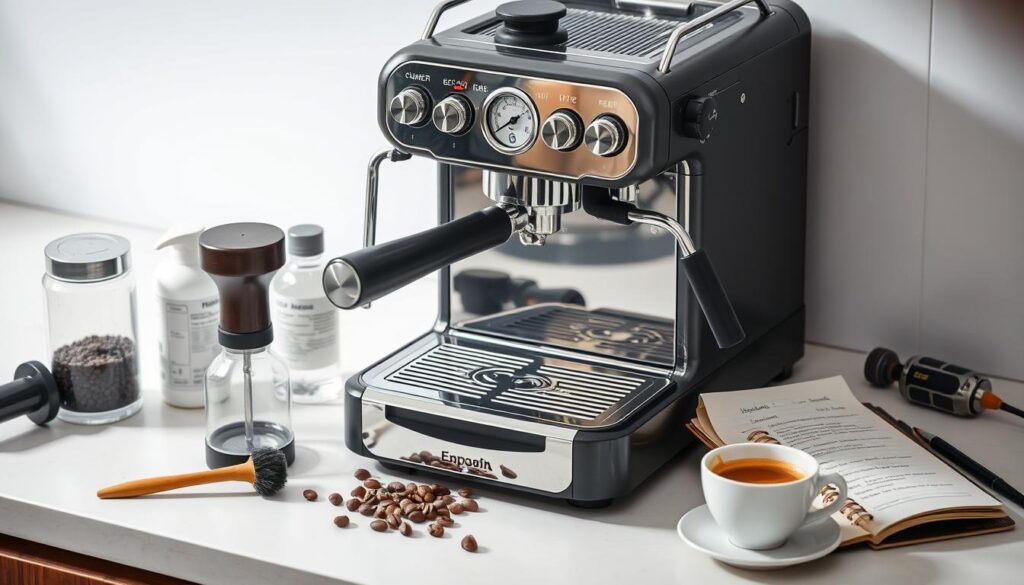
Keeping your machine clean and descaled is crucial. Here are some tips to help:
- Daily Cleaning: Clean the group head, portafilter, and steam wand. Also, wipe down the outside to remove any buildup.
- Backflushing: Use a special detergent to clean out oils and coffee grounds from the machine.
- Descaling: Use a descaling solution every month to stop mineral buildup. This keeps your machine running smoothly for years.
- Water Filter Replacement: Replace the water filter as the maker suggests. This keeps the water clean and stops scale from forming.
- Inspect Seals and Gaskets: Check and replace seals and gaskets often. This stops leaks and keeps the machine at the right pressure.
Following these steps helps keep your espresso tasting the same every time. It also makes your machine work better and more efficiently. Regular care is the secret to enjoying top-notch espresso shots.
By focusing on maintenance, your machine will last longer. And you’ll keep making amazing espresso.
Conclusion
Mastering espresso craft means knowing your machine inside out. You need to control pressure, temperature, and grind size. Each one affects the taste and quality of your espresso.
Getting the settings right can make your coffee experience better. Adjusting pressure, keeping the right temperature, and perfecting grind size are key. These steps help you make the perfect espresso shot.
Your espresso-making journey is just starting. Keep learning and trying new things to get better. By using these tips and staying open to new methods, you can become an espresso expert. Enjoy every step, relish each cup, and share your amazing espresso with others.
This website contains affiliate links. As an Amazon Associate, I earn from qualifying purchases. The content on this website was created with the help of AI.

